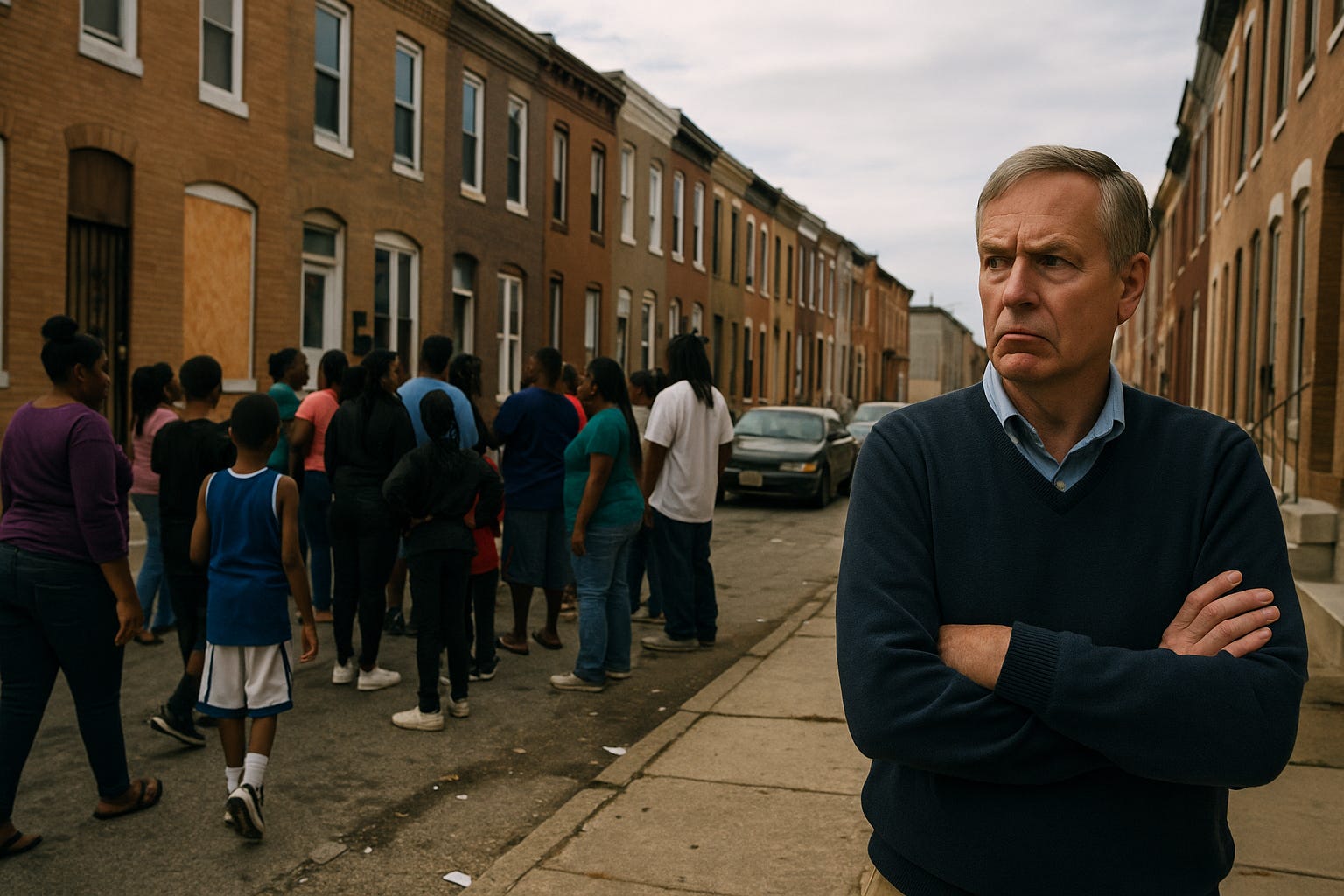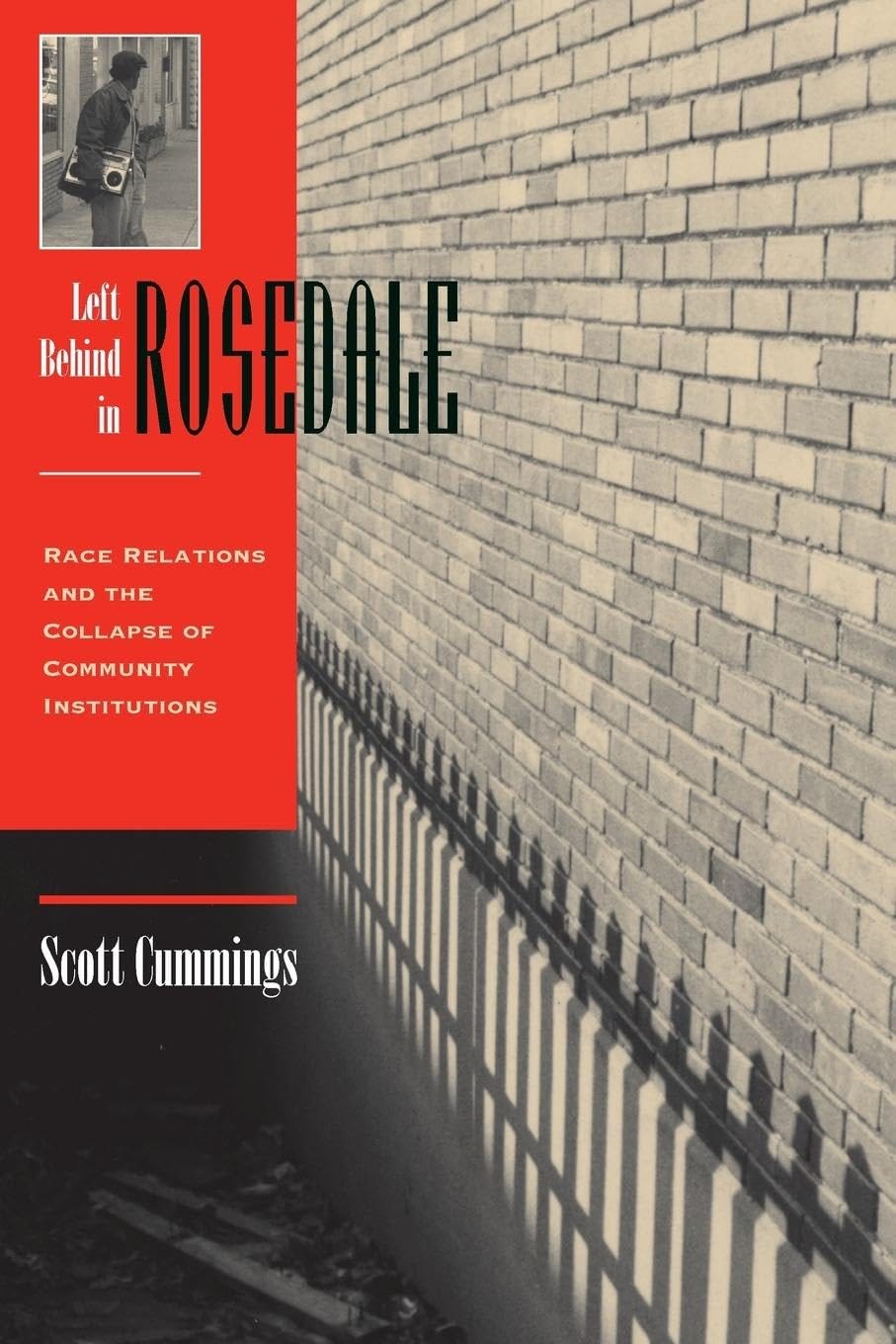The Book They Don’t Want You to Read About Demographic Change
White Flight Wasn’t the Cause. It Was the Escape.
Today I want to talk to you about a book I first came across in a Twitter thread back in 2021—and why its story should matter to you, even if it takes place in a small Texas neighborhood almost half a century ago.
The book is Left Behind in Rosedale by Scott L. Cummings. In the late 1970s, Cummings, an academic involved in community work, moved to “Rosedale” expecting to find the usual mix of local politics, civic clubs, and neighborhood disputes. Instead, he found himself documenting the rapid decline of a safe, stable, almost entirely white community, watching it become something unrecognizable within a single generation.
What he recorded isn’t just about Texas. It’s the same pattern you can now see wherever the native white population is being pushed aside—whether in European cities, Australian suburbs, or formerly quiet small towns that have changed almost overnight.
So today, we’re going to walk through what happened to Rosedale. We’ll see what life is like when the people who built a neighborhood are no longer the ones living there, and why no government program can ever bring it back once it tips. Most importantly, we’ll talk about what this means for you, and for the place you call home.
When White People No Longer Feel at Home
A neighborhood can change so much it stops being itself. For Rosedale, Texas—almost entirely white in 1960—that point came fast. Within thirty years, the white population had fallen to about 12 percent. Scott L. Cummings, an academic who moved there in the late 70s, saw it happen up close.
At the community center, elderly white residents spoke about being robbed, beaten, and harassed, often by teenagers from the new majority. Cummings admits feeling uneasy hearing it. His colleagues preferred to talk about a “white backlash” that never materialized.
One local official, when asked if elderly whites were being targeted, said “Probably.” His reasoning was simple: soon there’d be no elderly whites left to target.
That one answer sums up what played out in several U.S. cities: rapid demographic change, rising crime and fear, the collapse of institutions and trust. Cummings’ chapter list reads like a coroner’s notes—community erosion, constant fear among the old, street violence, interracial assaults, gangs, then a political spin job reframing it all as an “image” problem.
By the mid-90s, Rosedale was resegregated. Overwhelmingly black now, its white population was old, small, and powerless. The churches, norms, and safety were gone. No cavalry was coming.
This isn’t just Texas. It’s what happens anywhere a people lose majority status, and with it the means to preserve what made the place theirs. Rosedale isn’t unique. It’s a warning.
What Will Happen to Your Area if It Becomes Less White
Rosedale followed a pattern seen all over America. Once certain demographic thresholds are crossed, the outcome is obvious.
The first wave was middle-class black families. The area still worked, crime ticked up but didn’t explode, and white residents told themselves nothing fundamental had changed.
The second wave brought poorer families, often pushed from other parts of the city. Crime rose sharply, and the cultural rules that held the place together started to fray.
By the third wave, the tipping point was past. Churches, shops, and associations withered. Longtime residents left or locked themselves away. The social glue was gone.
Elderly whites lived with constant fear. They barred windows, kept to strict curfews, and stayed inside. It wasn’t only about crime—it was about no longer knowing or trusting the people around them. The faces at the store or in church were strangers, often with different customs, values, or even languages.
The last stage was normalization. Leaders insisted the “image” needed work, not the crime problem. Speaking honestly about the loss was recast as prejudice.
In Rosedale, the cycle took thirty years. Elsewhere it’s been faster. Once the original majority can’t hold cultural dominance, reversal is nearly impossible. This isn’t just about property values or statistics. It’s whether your home still feels like home, and whether you can keep it that way.
Myth vs. Reality – Why Official Explanations Always Miss the Point
When a neighborhood collapses, officials never lack a story. The problem is they usually tell the wrong one.
In Rosedale, two myths dominated. First, that poverty causes crime. Cummings’ accounts kill this outright—elderly people attacked for no reason, robbed of nothing, sometimes raped. No financial motive. These were acts of malice or dominance. One attacker was fueled by racial propaganda. Another staged a fake hate crime to hide his own spree.
Second, that minority neighborhoods are over-policed. In reality, police admitted there wasn’t just one serial rapist preying on elderly women, there were several. Many victims never reported assaults, convinced the system wouldn’t protect them.
Still, officials and activists turned the conversation toward fixing the “image.” Rosedale’s reputation, they said, was the real problem. Sidewalk repairs, storefront makeovers, and job programs would fix it. They didn’t. Millions in public and foundation money, even from the Ford Foundation, produced a few office jobs and fresh paint. Safety didn’t improve. Residents saw the truth: those in charge didn’t understand the problem or didn’t care.
Cummings compared the collapse to a natural disaster. The difference was this one was man-made, predictable, and avoidable. Admitting that meant breaking the post–civil rights script.
Poverty didn’t kill Rosedale. Neither did the caricature of “racism” peddled in the media. It was demographic change, more violence, less trust, and the destruction of the institutions that made it work. Everything else was cover.
The Solution – Building and Preserving White-Majority Areas
Rosedale’s story is a guide to what not to do. The whites who stayed weren’t diehards, they were stuck—no money to leave, family ties, or misplaced optimism. They paid in fear, isolation, and sometimes their lives.
Lesson one: don’t wait for the tipping point. Once you’re a minority, you can’t preserve the culture, norms, or safety. The slide is irreversible.
Lesson two: move strategically, not just to “somewhere nice.” Go where there are enough like-minded people to sustain a community, and where they’re willing to defend it. Talk plainly about demographics. Who your neighbors are matters as much as the house or the schools.
Lesson three: build defenses. In Rosedale, churches and clubs died because the base was gone. In your town, survival means joining or creating groups that bind people together. Youth programs, neighborhood watches, cultural events—all should strengthen identity.
Lesson four: use both soft and hard defenses. Soft means knowing neighbors, setting expectations, and applying social pressure. Hard means influencing local politics, zoning, schools, and policing.
And finally, commit. The forces that wrecked Rosedale took years, and they’re still at work. A white-majority community isn’t a trophy, it’s a constant effort.
Those who think “it won’t happen here” are always last to notice it already has. Your environment shapes your future more than almost anything else. Choose it well. Guard it.
■





This is a very important point:
"move strategically, not just to “somewhere nice.” Go where there are enough like-minded people to sustain a community, and where they’re willing to defend it. Talk plainly about demographics. Who your neighbors are matters as much as the house or the schools."
It can be especially difficult to transcend the sunk-cost fallacy when it comes to having settled on a property with one's family.
We upstanding White people are living, however, thorough a historically crucial time of decision.
Even if we've already escaped some city hellscape and moved out to the country, we can't allow short-sighted attatchment to a merely improved alternative to cloud our long-term vision and willingness to remain open to leaving "better" behind for something truly resilient that will stand the test of time and confer on our memories the admiration of our descendants.